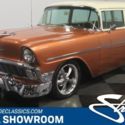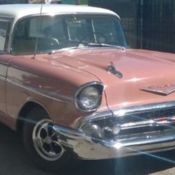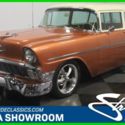1956 Chevrolet 210 Beauville Station Wagon
- Price:
- Condition: Used
- Make: Chevrolet
- Model: Bel Air/150/210
- Type: Wagon
- Year: 1956
- Mileage: 88,899
- VIN: B56J182059
- Color: Onyx Black over India Ivory
- Number of cylinders: 6
- Fuel: Gasoline
- Transmission: Automatic
- Interior color: Gray Cloth
- Vehicle Title: Clear
- Location: Cleveland, OH, United States
Description
Stories are what the old car hobby are all about. Sure, the cars are the centerpiece, but they wouldn’t be so important to our national psyche if they didn’t carry history behind them. Whether that’s personal history like your dad owned one just like it when you were a kid, or a kind of celebrity history like this 1956 Chevrolet 210 station wagon. Used in the David Lynch film “The Straight Story,” which is the tale of two brothers’ reconciliation with one of them embarking on a 240-mile drive on his lawn tractor (watch the movie, it’s far more compelling than it sounds). Filmed largely in West Union, Iowa, the director felt the need for a prop to make the scene-setting a bit more accurate, so he procured this handsome black and white wagon as the perfect piece of background noise to make his film look and feel authentic. During the shoot, the wagon quickly became a favorite among the crew and there were more than a few debates about who would get to take it home when filming wrapped. The lucky winner? The film’s writer-producer, who has owned and cherished it for the past 19 years. It is her name on the title today.
The car’s history before the movie is also fairly well-known to residents of that small town in Iowa where Lynch procured it. Kevin Vorwald, who sold it to the production company, purchased it in 1994 from a guy named Wayne Sutter of West Union, Iowa, and before that, it was a known fixture in a local garage for more than 20 years, where it sat with a prominent “NOT FOR SALE” sign in its window. Clearly, someone talked to the right person and brought the right amount of cash to pry it loose from its owner. Today, it’s in largely original condition, save for fresh upholstery on the seats and a few paint touch-ups here and there. The 1956 Chevrolets seem to be far less common than their siblings, which is surely due to a union strike that year that curtailed production. Nevertheless, there are many (myself included) who think the ‘56s are the most attractive of the Tri-Five Chevys and this two-tone wagon is a great piece of evidence to that end. It’s a 210, not a high-zoot Bel Air, and it’s a standard Beauville wagon with 4-doors, not a more unusual Handyman 2-door, but there’s a real sense of style to the car and it looks good from any angle. These are its original colors, of course, and the India Ivory over Onyx Black combination will always look good, no matter how long you keep this heirloom wagon. It’s got its share of bumps and bruises that tell the tale of time, but nothing that requires immediate attention save for perhaps a tailgate hinge that’s been tweaked and doesn’t quite close flush anymore. The finish still shines up well and as a car with a known history and mostly original paint, you know there’s no half-hearted workmanship hiding underneath. Is it perfect? Nope, and it’s not priced like a trailer-queen, either. But all four doors open and close nicely the hood latches without being slammed, and the soft gloss of the Magic Mirror acrylic enamel is impossible to replicate with today’s paints. The chrome and stainless is in great shape, with the bumpers showing their age but no critical damage. We polished up a lot of the stainless to really dress the car up, and aside from some light pitting on the cast parts, the whole car has a very appealing all-of-a-piece look we like a lot. Don’t restore this car, just enjoy! The interior, as I mentioned, has been reupholstered at some point. It’s not correct (we’re fairly certain it had vinyl when it was new) but it has an appropriate look and the gray cloth is quite a bit more comfortable than the sticky factory stuff. The filling underneath was probably replaced at the same time, as the cushions are firm and it’s easy to see how you could spend hours on a road trip without feeling beat-up when you got where you were going. This is a station wagon and a 210 at that, so there aren’t a lot of frills, but it does have an AM radio and a PowerGlide 2-speed automatic transmission, so anybody can handle it without any special training. The gauges are all operational and in good order, although the glass lens on the speedometer has cracked but that’s an easy fix. There’s a Motorola Volumatic AM radio in the center of the dash which powers up but doesn’t make sound, but the heater is powerful enough to drive you out of there on anything but a sub-zero morning. The original door panels are quite nice and the carpets are probably replacements, because they’re just too nice (those in the cargo area are surely original and show some age-appropriate fading). The headliner is likewise extremely nice, still bright white and not sagging or brittle. The cargo area is just as big as you remember, nicely finished and still ready to get to work hauling stuff from the hardware store or luggage on a road trip. Now don’t scoff at the 235 cubic inch “Blue Flame” six living under the hood, because it’s a total over-achiever. We have a 1955 Chevy with a 265 V8 sitting right next to it, and to be honest, the V8 isn’t a lot faster or more capable. Thanks to the PowerGlide’s torque converter, it steps off the line with vigor and pulls the wagon up to 60 MPH without any drama at all and it’s happy to cut through modern traffic without becoming a liability. We don’t believe the engine has ever been out of the car, although it does appear to show some recent top-end work and we sure can’t argue with the way it runs. It fires easily without a lot of drama and idles nicely with a buttery-smooth 6-cylinder soundtrack that’s pleasing in its own right. There’s correct light blue engine enamel clinging to the block and while it’s not in show condition, it’s really not bad at all with no leaking oil stains or other serious issues. A recent tune-up means there are fresh plugs and wires, the fuel system has a modern filter, and there are new hoses and clamps for the cooling system. The carburetor still inhales through its heavy-duty oil bath air filter and a period accessory bug screen hangs on the radiator. As I mentioned, it starts easily and really runs beautifully, so if you need a neat wagon to cruise around town, you could certainly do a lot worse than this. Underneath, it’s original, so don’t be expecting to show it with mirrors under it—it’s grungy. On the other hand, all the mechanical systems have been well-maintained and properly serviced so it tracks straight, the brakes feel confident, and even the exhaust system has just the right sound, not too loud but a bit of a grumble at idle. Even without power steering, it’s nimble and easy to manage, and the 2-speed PowerGlide automatic transmission is about as close to indestructible as such machines get. 4.11 gears out back mean it’s not made for 80 MPH highway cruising, but that’s part of why the six feels so lively and it’s so turbine smooth that it’s happy to spin along at modern highway speeds without issues. The suspension rides well for something designed to carry a load and it sits right, indicating that the springs are in good order. Standard steel wheels were painted to match the body and carry hubcaps and a set of G78-15 wide whitewall tires that are probably due for replacement if you’re going to drive the car any extended distances. This is not a perfect car, but if you’re a wagon person, you can certainly see the appeal. The colors are great, the interior is welcoming, and we just can’t argue with the way this handsome wagon drives. Perhaps you like the idea of a thrifty six or maybe this is the foundation of a spectacular wagon build, either way, you’re going to enjoy driving it. And the interesting film history is a nice bonus that probably doesn’t add value but does make this car a lot of fun to show and discuss at cruise nights. We like this wagon more than we expected, and if you come see and drive it, we’re pretty sure you will too. Call today! 1956 Chevrolet 210 Handyman Wagon Station Wagon 350 V8 Automatic Classic Vintage
1956 Chevrolet 210 Handyman Wagon Station Wagon 350 V8 Automatic Classic Vintage
Mileage: 802
 1956 Chevrolet Station Wagon
1956 Chevrolet Station Wagon
Mileage: 00000000
 1956 Chevrolet 210 2 door station wagon
1956 Chevrolet 210 2 door station wagon
Mileage: 4,019
 1956 Chevrolet Tri Five Nomad Station Wagon 2dr
1956 Chevrolet Tri Five Nomad Station Wagon 2dr
Mileage: 65000
 1956 Chevrolet Bel Air Nomad 2-door station wagon
1956 Chevrolet Bel Air Nomad 2-door station wagon
Mileage: 20
 1956 Chevrolet 210 9 Passenger station wagon - project
1956 Chevrolet 210 9 Passenger station wagon - project
Mileage: 90,000
 1956 Chevrolet Station Wagon W/New Crate Motor
1956 Chevrolet Station Wagon W/New Crate Motor
Mileage: 14,568
 1957 Chevy 210 4 door station wagon station 1956 1955 classic car antique car
1957 Chevy 210 4 door station wagon station 1956 1955 classic car antique car
Mileage: 51,424
 1956 Chevrolet 210 Handyman Wagon Station Wagon 1956 Handyman Wagon Used
1956 Chevrolet 210 Handyman Wagon Station Wagon 1956 Handyman Wagon Used
Mileage: 802
 1956 Chevrolet 210 4 Door Station Wagon No Reserve from Arizona
1956 Chevrolet 210 4 Door Station Wagon No Reserve from Arizona
Mileage: 999,999












